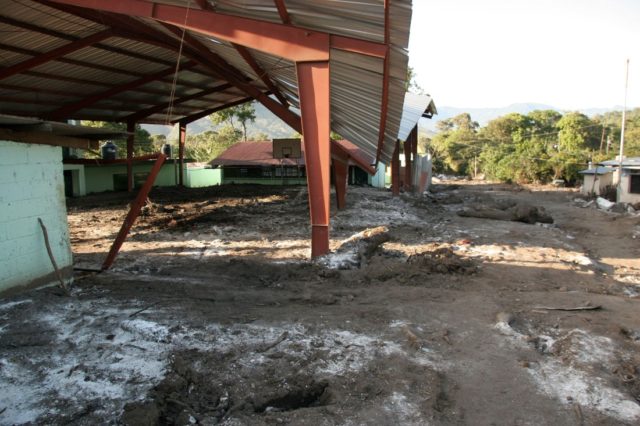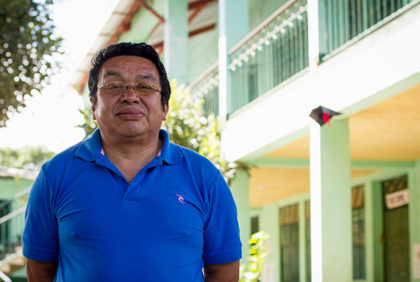
Don’t go, they warned him. Something terrible has happened.
When the sun rose the morning of October 5, 2005, Pedro Ajcabul left for work in the nearby village of Panabaj, Guatemala, where he taught second grade. His parents tried to stop him. They’d heard that overnight terrible waters had flooded the homes in the small, mountainside village where their son worked. But Ajcabul went to work anyway. Afterall, he had an important teacher’s meeting to attend. Ajcabul donned his boots and grabbed an umbrella and made his way to the outskirts of the village.
But when the second grade teacher arrived, he saw a nightmarish reality. Children and mothers shaking with cold, carrying whatever mud-covered belongings they could retrieve. Ajcabul saw twisted limbs of children poking out of the oozing ground. He saw a dazed man missing an ear.
In the wee hours of Wednesday morning, the rural village of Panabaj, Guatemala, had been ravaged by a river of mud that swept away homes, possessions, fathers, mothers, children. Nearly 1,400 of the 3,000 townspeople had been killed in the torrential rains and resulting mudslides from Hurricane Stan.
At Pedro Ajcabul’s school, a flood of debris had swept a giant boulder onto the basketball court, shattering windows and filling classrooms to the ceilings with sticks, garbage and mud. Everywhere, mud. Tree trunks gouged and cracked whatever walls had not already been toppled. A basketball hoop and the tops of a few trees stood above the mud, lone markers of what had been the school’s play yard. In the weeks to come, the second grade teacher would learn that nearly 200 students at the school perished in the disaster.

Of all the things lost on that day, perhaps the most dispiriting was the loss of the school. To the people of Panabaj, education represents hope for the future. That future was now in disarray, along with their scattered community, their classrooms filled with mud and their mourning families. But the people of Panabaj were not about to lose their school without a fight.
The Curious Rain
Just two days before it had started to rain – hard. Harder than usual. The rain didn’t stop. And the kids left Escuela Panabaj to go home. It was too loud, anyway. Too loud to hear their lessons with all that rain pounding down on the school’s corrugated tin roof. The teachers sent the kids home, sent them out into the stinging rain, sure they would come back to school the next day. But it rained through the night. And it rained through the next day. It was too much, the people in the village whispered. The electricity failed. Most of the townspeople went to bed, but some of them came out of their makeshift houses, the rain was so curious. Nothing like the usual rain in Guatemala in October. Not like the ever-present drizzle that makes everything damp all the time, that makes the air smell like mold. Not at all like that.
Rivulets of brick-red mud and trash flowed down through the village from los faldas or “the skirts,” the sloping highlands that lead down from the San Pedro Volcano to Lake Atitlan below. On these slopes, more than 3,000 people, mostly working families who pick coffee cherries in the surrounding plantations, live in cobbled-together homes. A few villagers got spooked and fled the town, some hid in the trees, but night was descending and most people tucked in, resigned to wait out the rain.
At 4:00 a.m., preschool teacher Diego Abraham Taccexól heard it. So did the school cook, Jilleuen Ninth Letona. It sounded like thunder. It sounded like a train. It didn’t sound like a wall of mud, rock and vegetation rushing toward the 250 homes of Panabaj. It didn’t sound like boulders tumbling in a half-mile long river of mud that, in a matter of seconds, smothered homes, trees, a hospital, a school. Because how could you know what sound that makes? Nothing like this had ever happened here before.
There are reports that, in the hours before the mudslide, the mayor sent out firefighters to warn people, to ask people to leave. But where could these families go in the middle of a rainy night? Most townspeople didn’t hear the sirens or the warnings, or, if they did, decided to wait it out, huddled with their children and elderly parents in the safest place they knew.
“In one moment, everything disappeared,” remembers Jilleuen Letona. “It was a matter of seconds. In that moment, we thought it was all a dream.” Letona lost her aunt and her three children, two grandchildren and one son-in-law in the devastation. She also lost her youngest sister. Months later, Letona’s father, too, would die of sadness as he sat on top of the mud where his home had been, where his youngest daughter had been buried alive. All the loss piling up like boulders on his chest.
Two days after the mudslide, rescue crews from outside the immediate area arrived to search for survivors. Instead, workers stuffed herbs in their noses and dug up corpses. Authorities debated what to do with this buried town and its surviving residents. Should they declare the community a mass gravesite and stop the nearly impossible feat of recovering bodies from the more than 16-foot deep sludge?
A Scattered Community
Disasters like the one suffered by the community of Panabaj are a reality of life in rural Guatemala. Nationwide, more than 500,000 Guatemalan families live in daily peril of landslides due to weather-related events, exacerbated by deforestation, poor quality construction and communities located in high-risk areas, according to a 2017 article published by Global Americans.
Each year, thousands of homes are destroyed or severely damaged due to mudslides and flooding. In some cases, after a disaster hits, entire communities are scattered or relocated when the government declares their homes uninhabitable. For the poorest and most marginalized communities, the upheaval caused by natural disasters is one more reason why daily survival in Guatemala is so tenuous.
After the landslide, surviving Panabaj residents fled anywhere. They stayed with friends or family in nearby villages. They filled makeshift shelters. But as the weeks and months passed, it was difficult for the residents to live apart.
“When your family is together, there is joy,” recalls teacher Diego Abraham Taccexól, “but when you are divided up, it’s so sad. Everyone disappears somewhere because each family went where they could find a place.”
“The School Will Continue”
In the aftermath of the mudslide, one fact became clear: The Panabaj school would shutter. Hundreds of children had died in the initial disaster, and the rest of the children, along with their families, had scattered to take refuge in other communities. The town was fractured, perhaps forever. There were no more kids left to teach, the Guatemalan government argued. The school was not needed anymore.

But the parents, teachers and school director protested. In some ways, losing the Panabaj school would’ve been a fatal blow to reassembling their broken community. The townspeople had lost their homes and families, but they refused to give up on their future: the surviving children.
“I’m from here, and I know my people,” says Panabaj School Director Salvador Gonzales y Gonzales. “We just lost many family members – fathers, mothers, children – and (the government) wants to kill our education as well? No.”
So the Panabaj School Director made a big promise to his community: “I said, ‘the kids are going to be outside underneath the trees having classes if they have to, but the school of Panabaj will continue to exist.”
So, it did.
A provisional school was set up in a building away from the town that combined the surviving children of Panabaj and surrounding communities. Slowly, families returned to their homes and children came back to school.
Eventually, workers and parents, along with the help of various non-profits cleaned out and repaired the original Panabaj school. And in 2012, the shuttered school of the town buried in mud and left for dead, opened its doors again.
“What about the next generation? That was the reason we couldn’t abandon the kids.” says teacher Ajcabul. “If a tragedy happens, we can’t just leave the community as if it were dead. So, we picked ourselves back up,”
Continuing the Fight for Education
After years of effort, the community of Panabaj rebuilt the school it had lost in the landslide. But keeping the dream and promise of education alive in Guatemala is an ongoing struggle. They currently have a building, but lack basic resources like books, pencils and paper needed for teaching. The children have returned, but face constant economic and social pressures to drop out early. The teachers have their jobs, but receive little training to develop the skills and knowledge they need to help students learn.
In 2018, Child Aid partnered with the Panabaj school to continue the rebuilding process. Thanks to a four-year sponsorship from Jim’s Organic Coffee, the school will receive the resources, training and support it needs to provide a quality education to the children of this very deserving community.
“Our hope is that Child Aid will take this rebuilt school to a new academic level worthy of the people it serves,” says Child Aid Country Director Angus Fredenburg.
Director Gonzales y Gonzales is grateful for the literacy program. “It is strengthening us and helping us bring change,” he says.

Today, third-grade teacher Pedro Ajcabul reads aloud to his class from a library of books provided by Child Aid and Jim’s Organic. Literacy Trainer Mildred Esquina assists Ajcabul in leading his class in a story mapping exercise designed to help bolster comprehension skills. After class, Esquina will follow-up with the teacher to see how well that exercise worked with his students and how to improve the experience.
“The people of Panabaj want what every community in Guatemala wants,” says Literacy Trainer Esquina. “They want more than a building, they want a school where learning happens. When I work in the Panabaj School, I know I’m helping to rebuild this community.”
It hasn’t been an easy recovery process for anyone, but through sheer willpower, the people of Panabaj kept a school running even as they quietly rebuilt their lives.
“It doesn’t matter if something happens to us, we must keep going,” says teacher Pedro Ajcabul. “The next generation has the right to an education. They have the right to achieve their goals, to keep dreaming.”